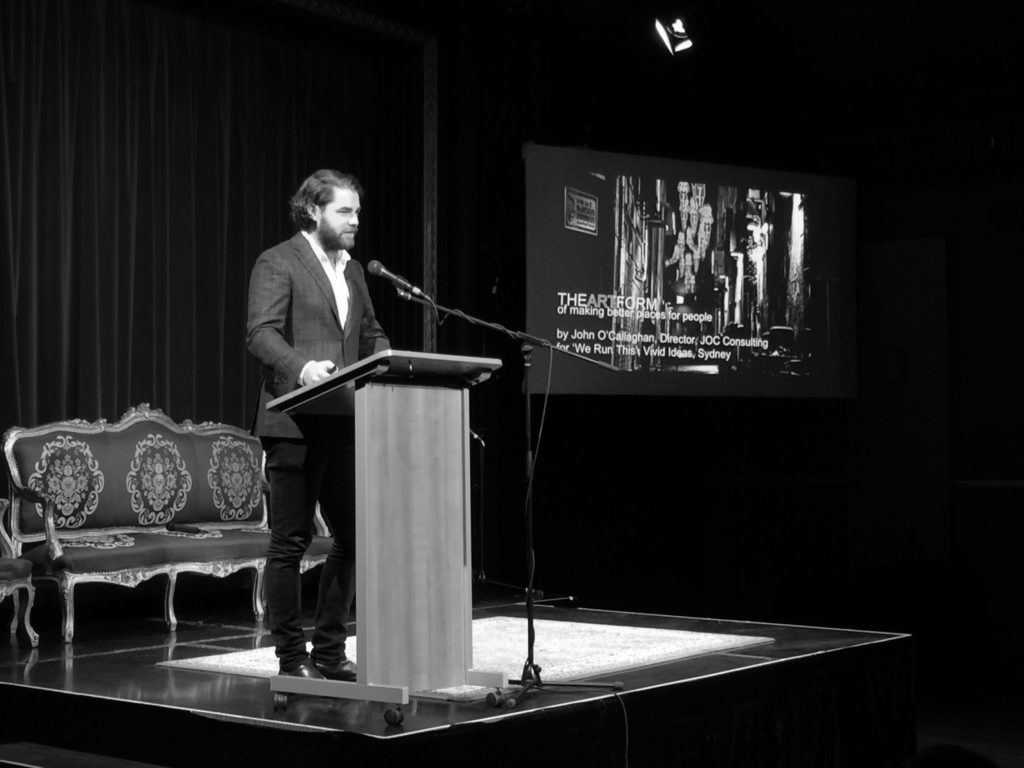#025

Rigorous discussion broke out at the Giant Dwarf Theatre on Friday 27th May 2016 as a part of We Run This. Drawing on some the ideas of artist run initiatives from across the country, academics, policy advocates, artists and urban planners, the day sought to start a national conversation around best practice and sustainability in the arts. As the event title suggested, the conversation was an attempt to burst the art bubble and encourage artist run initiatives to consider how they can better work with other sectors. As the creative producer of this event, I wanted to combine my experience with the School for Social Entrepreneurs with four years of volunteering and interning at different levels of the arts sector to provoke the arts community to go beyond anger and frustration. How do we work better with other sectors to ensure we are relevant beyond the art bubble? How can we think more entrepreneurially about art as business?
The day opened with a keynote by urban planner, John O’Callaghan of JOC Consulting. As John explains, he is in the business of making our cities more liveable and perceives artists to play an essential role in this process. He spoke to a number of examples around the world – in both developing and developed countries – where artists are engaging with public space to provoke ideas around active citizenship and civic engagement. He proposed that red tape, such as the coded language and system of Development Applications, need to be reconsidered in order to promote inclusive, engaging and liveable cities for all. Yet at the same time, sometimes it is better to ask for forgiveness than permission.
What does it mean to be independent in today’s arts ecology and the economy of the city more broadly? Surprising it took until the end of the day to directly address a key issue. The term clearly had different connotations depending on what local conditions arts workers and artists are responding to. In Tasmania, where the government has retracted funding from local activity to concentrate efforts on MONA and tourism, independence is developing a business model that enables spaces to operate free of government support. What that model looks like is yet to be determined, but having representatives from Constance in the audience and Sawtooth on the panel will hopefully encourage those from other parts of Australia to consider how they can help build this structure. For places like Western Sydney, where social and cultural infrastructure has been largely neglected despite housing over 2 million people, it is a different situation. Instead of working independently of Local Government, it is about strategically working with Council to meet both the needs of residents and unaddressed policy outcomes. In addition to this, where the infrastructure is not available, art organisations take to the streets and public space as sites for the development and presentation of work. Programs such as Bankstown Live and One Day For Peace by Urban Theatre Projects and FUNPARK (instigated by artist Karen Therese and a coalition of community organisations) have led the way for this framework in the suburbs. Their strength lies in drawing on locally meaningful stories with global relevance to create dynamic, engaging events.
In Alice Springs, the issue of independence and working with Local Government was a tension point. The conversation steered towards the perceived power imbalance between regulators and artists. The challenge put forward was to view independent art activities as products/services that produce what Spark Strategy refers to as a rethinking of not-for-profit to ‘profit for purpose.’ This shapes our attitudes towards money and profit in the arts sector. It acknowledges that we need money to function, but what differentiates us from commercial galleries is how we use that profit – to pay our workers and develop our social impact further.
WRT was loaded with provocations to the sector from both panel representatives and the audience. How do we promote our relevance to those still thinking about STEM? One example for modelling included The Groundswell Project (NSW) who place artists in hospitals (similar to an example in the UK that I forget the name of). What implications does the rising cost of living and homelessness have on artists when artist fees aren’t being paid? How do we stop pitting art against sport? Is there a model when we look at how they deliver interconnected career trajectories from grass roots through to professional level? Although as Sebastian Goldspink of ALASKA Projects pointed out, the career trajectory of artists is anything by linear.
Needless to say, the conversation has only just begun and where to go from here is yet to be determined. There is definitely potential for a series of conversations to follow on from We Run This. A stream of other events at Vivid Ideas, including those about creative enterprise and cooperatives, creative clustering in the Blue Mountains and working effectively with councils tie in well with We Run This. What has become apparent is that replying on the traditional model for artist run initiatives is not viable in today’s economy. Art administrators need to navigate the politics of the city and regulation to build relationships outside of the sector. The arts should not rely solely on advocating for itself, but position other sectors to want to advocate for us and with us.
